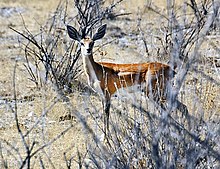Ibex
| Ibex | ||||||||||||
|---|---|---|---|---|---|---|---|---|---|---|---|---|

Ibex, male |
||||||||||||
| Systematics | ||||||||||||
|
||||||||||||
| Scientific name | ||||||||||||
| Raphicerus campestris | ||||||||||||
| ( Thunberg , 1811) |
The ibex ( Raphicerus campestris ) is a dwarf antelope that is widespread in the savannas of East Africa and southern Africa . In its area of distribution it is also known as the ibex ( English Steenbuck , Afrikaans Steenbok ) or in German-speaking countries as the stone antelope . In southern Africa the ibex is one of the most common small antelopes.
Appearance
The ibex reaches an average shoulder height of 52 centimeters. The weight is 11 kilograms.
The ibex has larger ears (with distinctive markings) than the otherwise very similar pallor . This antelope has a shoulder height of 50 cm. The back and the short tail are fawn brown and without markings, the belly and inside of the legs are white. The males have short, straight, pointed horns that do not protrude beyond the ears. The pre-eye glands in front of the large, dark brown eyes are noticeable in both sexes .
distribution and habitat
The ibex occurs in two widely separated areas on the African continent. It is native to both East Africa and Southern Africa. Presumably the distribution was continuous in the Pleistocene . The highest densities are found in drier areas such as the Karoo and Kalahari . As a habitat it prefers open areas with sufficient cover by tall grass or bush eyries. It is usually absent in forests, as well as in mountainous and rocky areas.
The ibex can be seen in the following nature reserves: Karru , Willem - Pretorius , Hluhluwe / Umfolozi , Mkuzi , Krügerpark , Pilanesberg , Kgalagadi (Kalahari) , Namib-Naukluft , Etoscha , Chobe , Hwange , Ngorongoro , Serengeti and Nairobi .
Way of life
The ibex almost exclusively eats green parts of plants such as young leaves, shoots, flowers and fruits of various plants. Due to the high water content of this food, it is usually not dependent on drinking water. In the dry season it digs for roots, tubers and onions and creates hollows that reach up to its shoulders. While eating, ibex occasionally kneel down in order to reach plants that they could not reach while standing.
Ibex are tied to territories that they defend against other same-sex conspecifics. These areas have fixed resting, dropping and feeding areas. The droppings serve to mark the territory. The ibex first scratch the ground, then urinate on this spot and deposit the feces on the urine. Finally, both of the front feet are lightly covered with sand. In addition, the ibex has a gland located under the chin, with which adult ibex mark branches and blades of grass.
There is no pronounced reproductive season, but births can be observed all year round. The wearing time is about seven months. Only one young is born. This is placed under cover and suckled by the mother in the morning and in the evening. The young animal only accompanies the mother animal after a period of three to four months.
Capricorns live to be 7 years or older.
literature
- Hadoram Shirihai: A Complete Guide to Antarctic Wildlife. The Birds and Marine Mammals of the Antarctic Continent and Southern Ocean . Alula Press, Degerby 2002, ISBN 951-98947-0-5 .
- Gus Mills et al. a .: The complete book of Southern African Mammals . Struik Winchester Editions, Cape Town 1997, ISBN 0-947430-56-3 .
- German: Mammals of southern Africa Könemann, Cologne 1999, ISBN 3-8290-3610-8 .
Web links
- Raphicerus campestris inthe IUCN 2013 Red List of Threatened Species . Listed by: IUCN SSC Antelope Specialist Group, 2008. Retrieved September 21, 2013.

